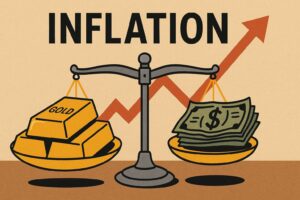
Gold has shattered records in 2025, surpassing the historic $4,000 per ounce milestone — and as of October 8, spot gold is trading as high as $4,041.71. Futures have climbed even higher, pushing toward $4,063.70. That’s up over 52% year-to-date. Even at these elevated levels, first-time investors are moving in, recognizing gold’s enduring role as a hedge against today’s economic uncertainty.
Why First-Time Investors Are Embracing Gold at Peak Prices
The rush of new gold buyers reflects a perfect storm of economic pressures that have undermined confidence in traditional assets. Persistent inflation, trade tensions, and growing doubts about central bank independence have made gold’s stability look increasingly attractive.
A striking demographic shift is underway. According to State Street’s 2024 Gold ETF Impact Study, high-net-worth investors have nearly doubled their allocations to gold over the past year, citing its reliability in turbulent markets. But this movement extends far beyond the wealthy. Retail investors — many entering for the first time — are buying both physical bullion and gold-backed ETFs to protect their savings from an uncertain economic horizon.
The Driving Forces Behind Record-High Gold Prices
Several powerful forces are converging to lift gold to all-time highs:
1. Central Bank Demand — Central banks remain steadfast buyers. In 2024, countries such as China, Poland, Türkiye, and India purchased more than 20 tonnes each, reinforcing a long-term floor under the gold price as they diversify away from U.S.-dollar reserves.
2. Geopolitical Tensions — Renewed trade wars and tariffs have rattled markets, raising fears of supply disruptions and inflationary pressures. The U.S.’s latest tariff actions against India and Mexico echo past eras of currency instability — the kind of environment in which gold historically shines.
3. Monetary Policy Shifts — With the Federal Reserve preparing to cut rates further, real yields are falling. That’s good news for gold, which becomes more attractive as interest-bearing assets lose their edge. Many analysts are now revising their gold forecasts as gold prices have blown by the $3,700–$3,800 level during the second half 2025.
Understanding Gold Investment Options for Beginners
For those entering the market amid record-high gold prices, understanding your investment avenues is key:
- Physical Gold: Direct ownership of coins or bars with no counterparty risk. Best-known options include American Gold Eagles and 1-oz gold bars, valued for liquidity and recognition.
- Gold ETFs: Exchange-traded funds offer exposure to the gold price without the need for storage, making them convenient for short-term or smaller allocations. However, they still carry counterparty risk, since investors rely on the fund’s management, custodians, and underlying financial infrastructure. In other words, you own a claim on gold — not the gold itself.
- Gold Mining Stocks: Mining shares can provide leveraged exposure to gold’s price movements, sometimes outperforming during bull markets. But they also introduce volatility and business risks that physical bullion doesn’t face — from operating costs and debt to management decisions and geopolitical pressures.
Ultimately, for those seeking the purest form of wealth preservation, physical gold stands apart. It’s the only option that offers complete ownership, privacy, and peace of mind — attributes that become even more valuable when markets turn uncertain.
Is Investing at Record Highs Still Wise?
The obvious question: Is it too late to buy gold?
History says no. Even after this surge, long-term fundamentals remain robust. Global investment demand hit a four-year high in 2024 — up 25% year-over-year — and central banks show no sign of slowing purchases.
Goldman Sachs now projects gold could approach $4,900 by the end of 2026, supported by persistent inflation and dollar weakness. Meanwhile, Fidelity International recently doubled its typical gold allocation in select funds, calling the metal’s bull run “far from over.”
For new investors, the smartest approach is discipline. Rather than trying to “catch the dip,” consider dollar-cost averaging — buying consistent amounts over time to smooth volatility and build a solid position gradually.
Managing Risk in a Record-High Market
Gold’s advantages don’t eliminate its risks. Investors should stay aware of:
- Short-Term Volatility — Gold can move sharply on rate expectations or currency swings.
- Storage Costs — Physical holdings require insured, secure storage.
- Product Premiums — Coins and bars carry varying markups above spot price.
The prudent rule of thumb: allocate 5–15% of your portfolio to precious metals as a long-term stabilizer, not a speculation.
Looking Ahead: Gold’s Role in Modern Portfolios
As fiscal deficits deepen and global trade realigns, gold’s role as a non-correlated store of value grows more essential. Central banks continue to accumulate at a pace well above the pre-2022 average, while retail ownership expands across both developed and emerging markets.
Breaking $4,000 per ounce isn’t the end of the story — it’s a new chapter in gold’s revaluation. In an era of financial experimentation and political friction, gold’s independence from any government or corporation makes it more than an asset class; it’s financial insurance.
People Also Ask
Why are gold prices hitting record highs in 2025?
Gold prices have surged past $4,000 per ounce in 2025 due to persistent inflation, central bank buying, and rising geopolitical risks. As global markets grow uncertain, investors are turning to gold as a proven hedge against financial instability. Learn more about what drives gold prices
Is it too late to invest in gold now that prices are at record highs?
Not necessarily. History shows gold tends to hold — and often grow — its value during periods of inflation and monetary easing. Many investors use dollar-cost averaging to build a position gradually, regardless of short-term price swings. Explore how to start your gold journey at GoldSilver’s New Investor Guide.
What’s the safest way to invest in gold right now?
Owning physical gold — coins or bars — offers the greatest security because it carries no counterparty risk. Unlike paper gold or ETFs, physical bullion is a tangible asset you fully control, independent of financial institutions.
Are gold ETFs a good alternative to buying physical gold?
Gold ETFs are convenient for trading and portfolio diversification, but they come with counterparty risk since investors rely on fund managers, custodians, and third parties. You own a claim on gold, not the gold itself. For investors seeking true independence, physical gold remains the preferred choice.
How do gold mining stocks compare to owning gold bullion?
Gold mining stocks can rise faster than the gold price during bull markets, but they’re also far more volatile and subject to company-specific risks like debt, management, and operating costs. Physical gold, by contrast, has no overhead or performance risk — it simply preserves purchasing power.
Get Gold & Silver Insights Direct to Your Inbox
Join thousands of smart investors who receive expert analysis, market updates, and exclusive deals every week.





![Is Now the Best Time to Buy Silver? [Silver 2025–2030 Forecasts]](https://goldsilver.com/wp-content/uploads/2025/11/price-of-silver-300x155.jpg)


